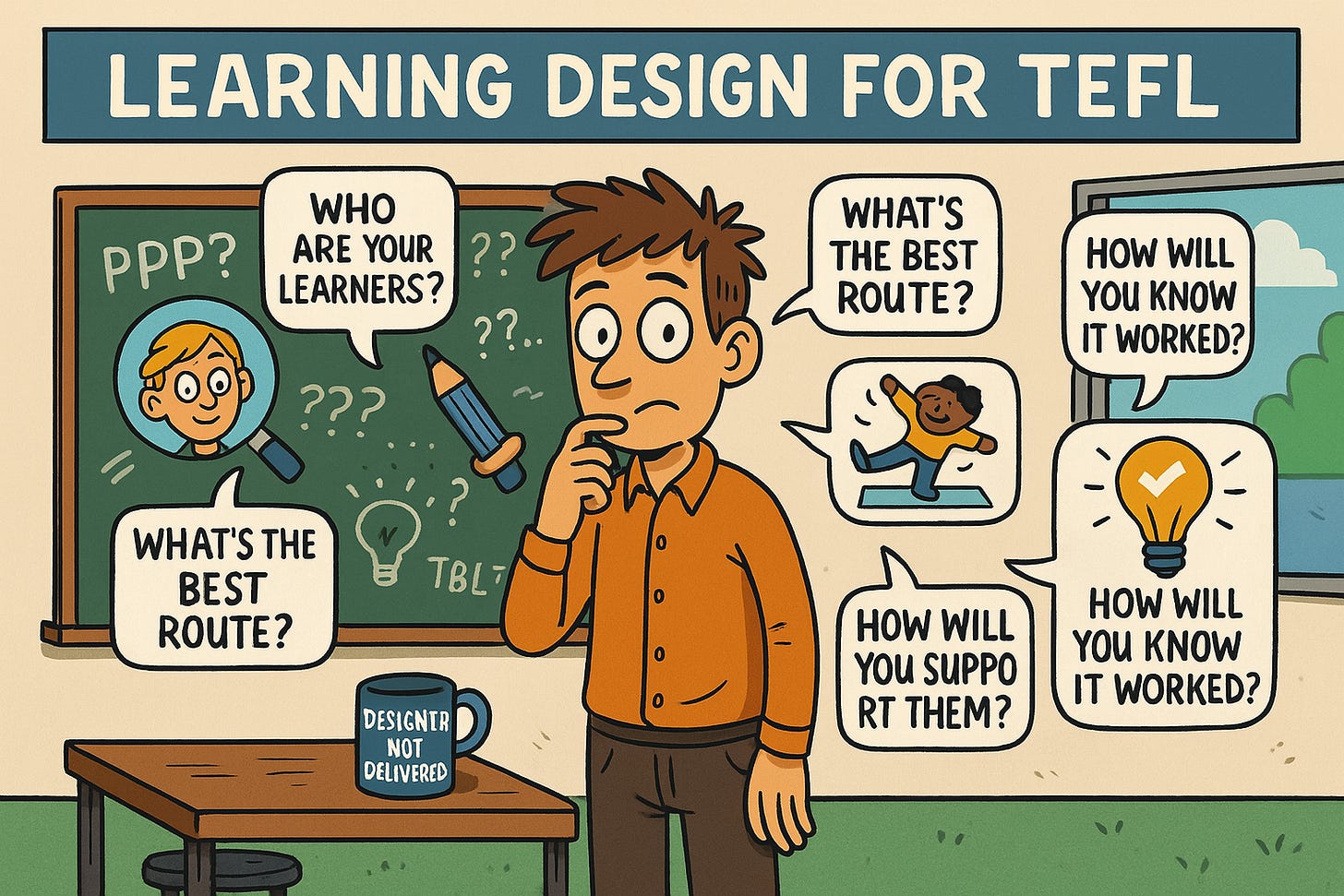Learning Design for TEFL
How to make every lesson count.
The success of a lesson isn’t about flashy tech or perfect grammar explanations. It’s largely about learning design.
And yet most TEFL teachers never get taught how to design learning. We get handed a coursebook and told to teach two pages per class. Maybe we were shown how to write aims or plan an activity - but no one explained why certain lessons flow and others flop.
Let’s fix that.
In this article, we’ll walk through what learning design actually means, why it matters, and how you can use it to plan better lessons - without spending hours writing lesson plans.
What is learning design in TEFL?
Learning design is the intentional structure behind your teaching.
It’s how you shape a student’s journey - from where they are, to where you want them to be. It’s not the same as lesson planning, though it guides every lesson plan you write.
Instead of “How do I teach this grammar point?” it asks:
Who are my learners?
What should they be able to do next?
What’s the best way to get them there?
What other factors should I consider?
It’s not a rigid formula. It’s a flexible thinking tool that every teacher should have.
Why learning design matters
Because teaching from the coursebook isn’t enough.
Learning design helps you:
Build more engaging lessons.
Make better decisions on what to teach and how.
Adapt to different students, levels, and contexts.
Focus on outcomes, not just activities.
It gives you a toolkit for shaping learning intentionally — whether you’re planning a lesson, a week, or a full course.
But here’s the truth: most of us never learned this.
TEFL training focuses on methods, not design. You’re taught to deliver PPP or ESA lessons, but not how to decide which to use — or how to adapt when your students don’t get it.
So what do we do? We follow the coursebook. It’s safe, predictable, and structured.
But it’s also limiting. And if your lessons feel flat or repetitive, that’s probably why.
How to start designing learning (without overcomplicating it)
Here’s a practical guide to get started. No jargon. No 10-page lesson plans. Just five questions:
1. Who are your learners?
Think: age, level, goals, interests, common mistakes. What do they want? What do they struggle with? What makes them switch off — or light up?
2. What’s the outcome?
Start with the end. “By the end of the lesson, students will be better able to…” Keep it simple. One clear, achievable outcome is better than five vague ones.
3. What’s the best route there?
Choose your structure:
You can mix and match. The best teachers bend the rules.
4. How will you support students?
Use scaffolding, interaction patterns, cognitive load and differentiation:
Will students work alone, in pairs, or groups?
What support will weaker students need?
How will you stretch stronger ones?
5. How will you know it worked?
What will success look or sound like? Plan ways to check understanding - and don’t wait until the end of class to do it.
How AI can help with learning design
You don’t have to do it all yourself.
Tools like ChatGPT can:
Suggest lesson aims and contexts based on your students.
Generate ideas for activities at different levels.
Help you shift a lesson from PPP to TBLT in seconds.
Check alignment between your aim, task, and assessment.
Scaffold a reading or personalise an activity for a student who loves K-pop and cats.
You can even upload your plan and ask for feedback.
Just don’t ask it to teach the class for you. Yet.
Top tips
Don’t overdo it. Start with one tweak per lesson.
Don’t forget your students. Build lessons around them, not the book.
Don’t skip the post-lesson reflection. “What did they learn?” is the most important question you can ask.
Learning design is a habit. Like lesson planning, it gets faster — and more powerful — the more you use it.
If you liked this article, you’ll love my books:
📝 Lesson Planning for Language Teachers - Plan better, faster, and stress-free.
👩🎓 Essential Classroom Management - Develop calm students and a classroom full of learning.
🏰 Storytelling for Language Teachers - Use the power of storytelling to transform your lessons.
🤖 ChatGPT for Language Teacher 2025 - A collection of AI prompts and techniques to work better, faster.
💭 Reflective Teaching Practice Journal - Improve your teaching in five minutes daily.



